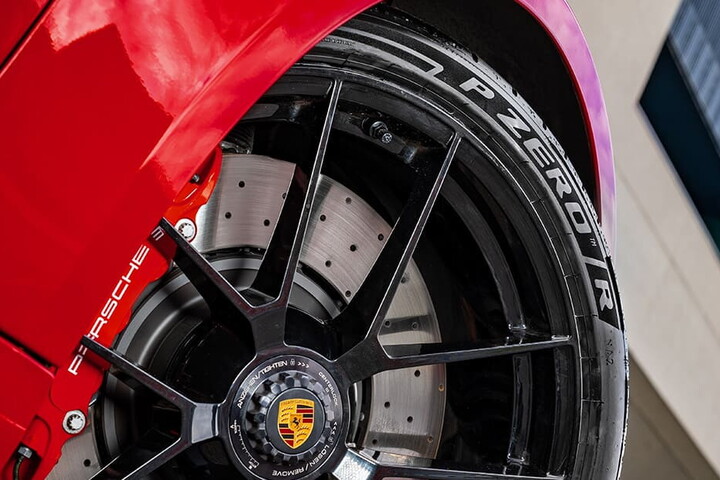Back when the Jaguar was a cub
When the Jaguar XJ220 concept car first appeared to the world, back in 1988 at the Birmingham Motor Show in England, it wore Pirelli P Zero tyres – which at the time were an entirely new idea themselves, having been created only a couple of years earlier to equip the equally impressive Ferrari F40.
The difference was that Ferrari had an established tradition of building supercars, whereas Jaguar's staple was producing prestigious saloons. As a result, the XJ220 project was known as a ‘Saturday Club Car': a car that a crack team of engineers gave up their weekends to create as a side-line to their day jobs.
When the XJ220 was born, turning it into a production car one day was still a distant dream. Instead, it was based on the principles of a pure racing car: about as far removed from day-to-day production as it was possible to get.
And there were some outlandish ideas to go with this pet project. Even before McLaren had thought of it with the F1 road car, the Jaguar XJ220 was originally envisaged as a three-seater. But to do so would make it too long – so soon it was back to being a two-seater, with an aluminium body. The original concept also called for a V12 engine and four-wheel drive. What nobody had really anticipated, once it took to the Birmingham Motor Show with its P Zero tyres, was that people would instantly love it – and start placing orders in their thousands. Perhaps with something of a shock, Jaguar soon realised that they would now actually have to build it. And with no room at the main factory in Longbridge, England, production was entrusted to the TWR racing team at Bloxham in Oxfordshire, which also ran Jaguar's endurance racing programme.

Racing to success
With the pragmatism and fat-shaming that defines every race team, TWR soon concluded that the original V12, four-wheel drive XJ220 concept was simply too complex and heavy (the driveshaft would have to run straight through the cabin, for a start). So, it then became rear-wheel drive, with the addition of two turbos to the 3.5-litre V6 to give it the necessary 450-horsepower shove. That treatment certainly worked, as at the time of its launch, the XJ220 was the fastest production car in the world. Formula 1 driver Martin Brundle took it to 217mph (349kph) at the Nardo test track in Italy in June 1992 to prove the point, although tantalisingly, it still fell slightly short of the 220mph maximum it had targeted. That formed part of Jaguar's naming tradition: the famous XK120 (for which modern, tailor-made Pirelli tyres can also be obtained these days) could crack 120mph.

Part of the Collezione
As the XJ220 approaches its 25th birthday since starting production in 1992 – and it's certainly aged well – Pirelli has released a range of tyres newly-created for this pioneering supercar. These P Zero tyres combine state of the art technology with classic looks, and they are precisely tailored to the specific characteristics of the XJ220. The new tyres for the XJ220 form part of the Pirelli ‘Collezione': an exclusive family of tyres for the most prestigious classic cars, designed using many of the methodologies behind Pirelli's renowned range of modern ultra high performance tyres.
Although these tyres are intended for road use, they are actually made by Pirelli's motorsport facilities, which benefit from particular expertise in producing small production runs of tyres designed to deliver extreme performance. Each tyre is marked ‘J' on the sidewall, denoting that it has been specifically made for Jaguar.
The result is a car that feels even more dynamic than it did when it first left the factory, as a group of international journalists were able to sample during an event in Germany recently. And it's another good example of how history is often circular. The XJ220 first saw the light of day with P Zero – and now it's back with Pirelli once more.
Here are some curiosities about this special supercar:
- 450 horsepower and 5 manual gears, it belongs to top class cars together with Aston Martin, Lamborghini or Bentley;
- It weighs 3,240 lb and the engine is a twin-turbocharged V6 with a maximum torque of 475 lb⋅ft;
- Concerning the speed of this sports car, it was the fastest car in 1992-1993 with a top speed of 217 mph and the news entered the Guinness World Record. Martin Brundle, the winner of Le Mans competition was behind the wheel when the top speed was reached;
- As a prototype, in 1991, the car recorded the fastest lap time: 7 minutes, 46 seconds and 36 milliseconds;
- Jaguar decided to produce only few models of this vehicle in its first production;
- The numbers in the name of the car refer to the top speed, in miles per hour, which were targeted for the model;
- Wheels and tyres are custom designed for a great fast driving experience




